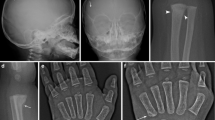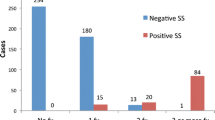Abstract
Background
Spinal fractures are uncommon manifestations of child abuse and elimination of the lateral views of the spine from the initial skeletal survey protocol has been recommended.
Objective
To establish the prevalence of spinal fractures detected on skeletal surveys performed for suspected child abuse and their association with intracranial injury (ICI).
Materials and methods
The ACR standardized skeletal surveys and neuroimaging studies of 751 children (ages 0–4 years) were reviewed. A positive skeletal survey was defined as having one or more clinically unsuspected fractures.
Results
Fourteen children had a total of 22 definite spinal fractures. This constituted 1.9% (14/751) of the total cohort, and 9.7% (14/145) of children with a positive skeletal survey. Advanced imaging confirmed the fractures in 13 of the 14 children and demonstrated 12 additional spinal fractures. In five cases, spinal fractures were the only positive skeletal findings. In 71% (10/14) of the children, the spinal fractures were accompanied by ICI. Children with spinal fractures were at significantly greater risk for ICI than those without spinal injury (P < 0.05).
Conclusion
Spinal fractures are not rare in children with positive skeletal surveys performed for suspected abuse and they may be the only indication of skeletal trauma. There is an association between spinal fractures and ICI.





Similar content being viewed by others
References
Galleno H, Oppenheim WL (1982) The battered child syndrome revisited. Clin Orthop Relat Res 162:11–19
King J, Diefendorf D, Apthorp J et al (1988) Analysis of 429 fractures in 189 battered children. J Pediatr Orthop 8:585–589
Kleinman PK, Marks SC Jr, Richmond JM et al (1995) Inflicted skeletal injury: a postmortem radiologic-histopathologic study in 31 infants. AJR Am J Roentgenol 165:647–650
Kogutt MS, Swischuk LE, Fagan CJ (1974) Patterns of injury and significance of uncommon fractures in the battered child syndrome. Am J Roentgenol Radium Ther Nucl Med 121:143–149
Merten DF, Radkowski MA, Leonidas JC (1983) The abused child: a radiological reappraisal. Radiology 146:377–381
Kleinman PK (1987) Diagnostic imaging of child abuse. Williams & Wilkins, Baltimore, pp 149–167
Belfer RA, Klein BL, Orr L (2001) Use of the skeletal survey in the evaluation of child maltreatment. Am J Emerg Med 19:122–124
Day F, Clegg S, McPhillips M et al (2006) A retrospective case series of skeletal surveys in children with suspected non-accidental injury. J Clin Forensic Med 13:55–59
Karmazyn B, Lewis ME, Jennings SG et al (2011) The prevalence of uncommon fractures on skeletal surveys performed to evaluate for suspected abuse in 930 children: should practice guidelines change? AJR Am J Roentgenol 197:W159–W163
Kleinman PK, Morris NB, Makris J et al (2013) Yield of radiographic skeletal surveys for detection of hand, foot, and spine fractures in suspected child abuse. AJR Am J Roentgenol 200:1–4
Swischuk LE (1969) Spine and spinal cord trauma in the battered child syndrome. Radiology 92:733–738
Kemp AM, Joshi AH, Mann M et al (2010) What are the clinical and radiological characteristics of spinal injuries from physical abuse: a systematic review. Arch Dis Child 95:355–360
Jha P, Stein-Wexler R, Coutler K et al (2013) Optimizing bone surveys performed for non-accidental trauma with attention to maximizing diagnostic yield while minimizing radiation exposure. Pediatr Radiol. doi:10.1007/s00247-012-2614-9 Epub ahead of print 29 January
Lindberg DM, Harper NS, Laskey AL et al (2013) Prevalence of abusive fractures of the hands, feet, spine, or pelvis on skeletal survey: perhaps “uncommon” is more common than suggested. Pediatr Emerg Care 29:26–29
Meyer JS, Gunderman R, Coley BD et al (2011) ACR appropriateness criteria(®) on suspected physical abuse-child. J Am Coll Radiol 8:87–94
American Academy of Pediatrics Section on Radiology (2009) Diagnostic imaging of child abuse. Pediatrics 123:1430–1435
Reston VA (2011) ACR-SPR practice guideline for skeletal surveys in children: revised 2011 (resolution 54). J Am Coll Radiol 1–6
Duffy SO, Squires J, Fromkin JB et al (2011) Use of skeletal surveys to evaluate for physical abuse: analysis of 703 consecutive skeletal surveys. Pediatrics 127:e47–e52
Tran B, Silvera M, Newton A et al (2007) Inflicted T12 fracture-dislocation: CT/MRI correlation and mechanistic implications. Pediatr Radiol 37:1171–1173
Astley R (1953) Multiple metaphyseal fractures in small children (metaphyseal fragility of bone). Br J Radiol 26:577–583
Kleinman PL, Kleinman PK, Savageau JA (2004) Suspected infant abuse: radiographic skeletal survey practices in pediatric health care facilities. Radiology 233:477–485
Karmazyn B, Duhn RD, Jennings SG et al (2011) Long bone fracture detection in suspected child abuse: contribution of lateral views. Pediatr Radiol 42:463–469
Harlan S, Nixon G, Campbell K et al (2009) Follow-up skeletal surveys for nonaccidental trauma: can a more limited survey be performed? Pediatr Radiol 39:962–968
Sonik A, Stein-Wexler R, Rogers KK et al (2010) Follow-up skeletal surveys for suspected non-accidental trauma: Can a more limited survey be performed without compromising diagnostic information? Child Abuse Negl 34:804–806
Drubach LA, Johnston PR, Newton AW et al (2010) Skeletal trauma in child abuse: detection with 18F-NaF PET. Radiology 255:173–181
Finch GD, Barnes MJ (1998) Major cervical spine injuries in children and adolescents. J Pediatr Orthop 18:811–814
Leonard M, Sproule J, McCormack D (2007) Paediatric spinal trauma and associated injuries. Injury 38:188–193
Mahan ST, Mooney DP, Karlin LI et al (2009) Multiple level injuries in pediatric spinal trauma. J Trauma 67:537–542
Twomey EL, Iemsawatdikul K, Stephens BG et al (2004) Multiple thoracic vertebral compression fractures caused by non-accidental injury: case report with radiological-pathological correlation. Pediatr Radiol 34:665–668
Feldman KW, Avellino AM, Sugar NF et al (2008) Cervical spinal cord injury in abused children. Pediatr Emerg Care 24:222–227
Piteau SJ, Ward MGK, Barrowman NJ et al (2012) Clinical and radiographic characteristics associated with abusive and nonabusive head trauma: a systematic review. Pediatrics 130:315–323
Koumellis P, McConachie NS, Jaspan T (2009) Spinal subdural haematomas in children with non-accidental head injury. Arch Dis Child 94:216–219
Conflicts of interest
None
Author information
Authors and Affiliations
Corresponding author
Rights and permissions
About this article
Cite this article
Barber, I., Perez-Rossello, J.M., Wilson, C.R. et al. Prevalence and relevance of pediatric spinal fractures in suspected child abuse. Pediatr Radiol 43, 1507–1515 (2013). https://doi.org/10.1007/s00247-013-2726-x
Received:
Revised:
Accepted:
Published:
Issue Date:
DOI: https://doi.org/10.1007/s00247-013-2726-x




